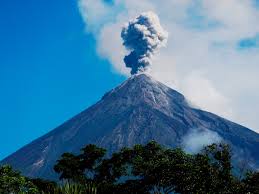
Guatemala’s ‘Volcano of Fire’ Erupts with Ash and Lava, Forcing Hundreds to Evacuate

 :
| Updated On: 06-Jun-2025 @ 12:25 pm
:
| Updated On: 06-Jun-2025 @ 12:25 pmSHARE
Guatemalan authorities have ordered the evacuation of hundreds of people following a major eruption of Volcán de Fuego, Central America’s most active volcano. This powerful eruption sent thick plumes of gas and ash thousands of meters into the sky, posing serious threats to nearby communities. The country’s National Coordinator for Disaster Reduction (CONRED) released an emergency bulletin on Thursday night, confirming that hot gases and volcanic materials had been expelled up to 7 kilometers (around 4 miles) from the volcano’s crater.
Volcán de Fuego, also known as the “Volcano of Fire,” is situated approximately 35 kilometers (22 miles) southwest of the capital, Guatemala City. Authorities have instructed residents from communities near the volcano to evacuate and move to designated shelters for safety. As of now, at least 594 people from five different communities in the Chimaltenango, Escuintla, and Sacatepequez departments have been relocated to shelters, according to CONRED spokesperson Juan Laureano. Officials have warned that the number of evacuees is likely to rise as volcanic activity continues.
In response to the eruption, the Guatemalan government has implemented several precautionary measures. Classes at 39 schools in the affected regions have been suspended, and a major road connecting the southern part of the country to the historic city of Antigua, a UNESCO World Heritage Site, has been closed. Social media images and videos show dramatic visuals of lava flowing down the slopes, along with a destructive combination of ash, rocks, and water rushing through the surrounding areas, further threatening lives and infrastructure.
The volcanic ash and gas clouds have impacted numerous communities located to the northwest, west, and southwest of the volcano. CONRED noted that these emissions are significantly affecting the air quality and visibility in those areas. According to Guatemala’s National Institute of Seismology, Volcanology, Meteorology, and Hydrology (INSIVUMEH), the ongoing volcanic activity is expected to continue for approximately 40 hours. Ash clouds have been observed reaching altitudes between 3,000 and 7,000 meters (2 to 4 miles), creating potential hazards for aviation and air navigation in the region.
Volcán de Fuego stands at a height of 3,763 meters (12,350 feet) and is known for its frequent eruptions, making it one of the most active volcanoes in Central America. Over the years, it has necessitated multiple large-scale evacuations. The most recent eruption prior to this one occurred in March 2025. However, the deadliest in recent memory happened in June 2018, when rivers of lava cascaded down the volcano’s slopes, destroying nearby villages. That catastrophic eruption claimed the lives of 215 people and left over 200 missing, underlining the deadly power and unpredictability of the volcano.
Authorities continue to monitor the situation closely and have urged citizens to remain alert and adhere to evacuation orders. With the volcanic activity showing no immediate signs of subsiding, emergency services remain on high alert to manage further evacuations and ensure public safety in the affected regions.
Contact Us
House. No. : 163, Second Floor Haridev Rd, near Puberun Path, Hatigaon,Guwahati, Assam 781038.
E-mail : assaminkcontact@gmail.com
Contact : +91 8811887662
Enquiry
×
Reporter Login
×